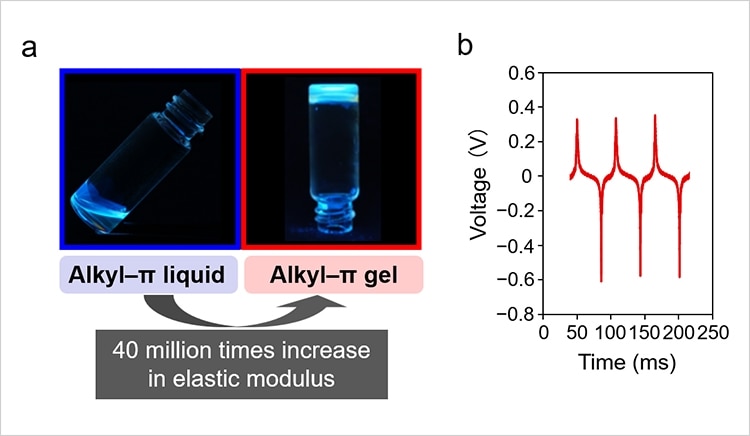
Image a represents the alkyl–π liquid and an alkyl–π gel in vials. Meanwhile, image b shows the response of the alkyl–π gel vibration sensor to 17 Hz vibrations. (Image Credit: Takashi Nakanishi National Institute for Materials Science)
Researchers from Hokkaido University, the National Institute for Materials Science (NTMS), and Meiji Pharmaceutical University created a gel electret: Alkyl–π that stably retains a large electrostatic charge. By combining that gel with flexible electrodes, they made a sensor that perceives low-frequency vibrations, which transform into output voltage signals. It may become practical to wear as a healthcare sensor in the future.
“These alkyl-π liquids and alkyl-π gels are attracting attention as a new generation of functional soft materials that exhibit optoelectronic functions such as luminescence, photoconductivity, electrochromic, and electret properties,” says Dr. Takashi Nakanishi.
Electrets are dialectic materials capable of permanently storing a charge. NIMS led the project to produce a room temperature, low-volatility alkyl–π liquid made of a π-conjugated dye moiety and flexible, branched alkyl chains. Alkyl- π liquids retain an electric charge, are easy to form, and are applied to other materials via painting and impregnation.
However, combining this liquid with electrodes causes sealing and immobilization issues, which result in leakage. Additionally, the alkyl–π liquids must have higher electrostatic charge capacities to boost power generation.
The team created an alkyl–π gel to address that issue. They achieved this by adding a tiny amount of a low-molecular-weight gelator to an alkyl-z liquid. This gel’s elastic storage modulus is 40 million times that of its liquid counterpart and can be simplified by fixation and sealing. In addition, the electric power of this gel is boosted by 24% due to the gel’s better electric charge retention capability compared to the liquid.
Afterward, the researchers added flexible electrodes to the gel-electret, producing a vibration sensor that perceived vibrations as low as 17 Hz. Those vibrations are then converted into output voltages (600 mV), which is 83% higher compared to the voltage produced by an alkyl–π liquid electret-based sensor.
The next step involves creating wearable sensors with a stronger alkyl–π gel and improved charging electrets properties, like charge capacity and charge life. Doing so means the sensor can respond to subtle vibrations and varying strain deformations. As a bonus, the gel is recyclable and reusable, so it can contribute to a circular economy.
Have a story tip? Message me at: http://twitter.com/Cabe_Atwell
